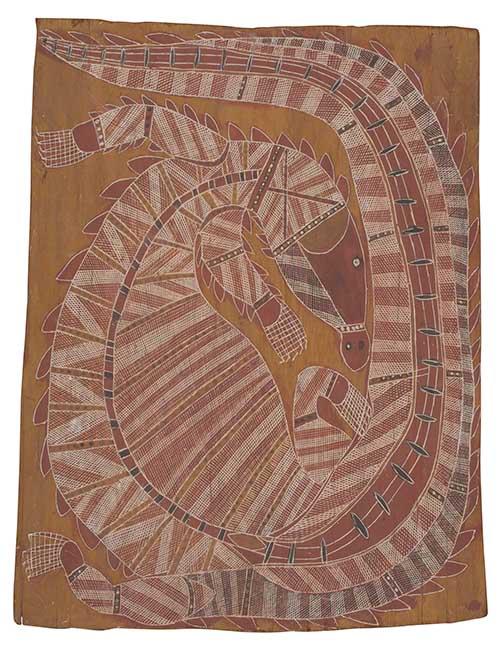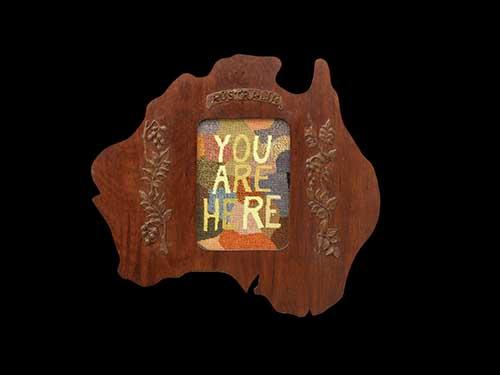
The sun sets over the Indian Ocean and its golden rays bounce off, absorb into and shine through diverse materials from steel to wood, string, plastic, tape, wool, granite and bronze, shaped into all manner of forms. The beach is thronged with people taking in this year's artistic offerings; bubbling with an undercurrent of curiosity magnetised toward the works from international, national and local artists all over the beach, groin and surrounding rise. There are pieces that immediately impress with scale and visual impact and others made for a more nuanced eye.
For the first time in over a decade of its running, durational performance is part of the exhibition. WA artist Olga Cironis has found a way to live the Australian dream and spend the summer on the beach. Her sculpture is herself and guests living in a donga as used in mining encampments. Attendant to seaside leisure this work speaks of questions related to immigration and belonging as a Greek Australian within Australian society. Cironis is well known for politically incisive works that challenge stereotypes of identity and tackle big questions with acerbic wit.
Throughout the show there are moments of incongruity between site and sculpture, like a square block thrust into a circle slot, some works are awkwardly placed. Winner of the People’s Choice Award, Wave 1 by Annette Thas has a certain dissonance about it, is both attractive and repulsive. It is a human-scale wave of blonde Barbie dolls that evoke infantile fantasies as much as the quest for the body beautiful innate to beach culture and is both humorous and creepy with a B-grade horror flavour.
Alongside the works that jostle with their environment, there are those that offer moments of harmony and synchronicity and even look as though they have grown out of the ground. This is the case with Marcus Tatton’s Primordial, where three frond-like forms unfurl as subtle in a textural organicity that mirrors the rough earth from which they spring. The same could be said for Ron Gomboc’s copper sculpture, a meditation of the idea of family that features a series of whimsical fronds.
Two WA artists reflect on our mammalian friends out in the ocean beyond, as a timely topic considering recent politics over the cessation of Japanese whaling in Australian waters. Tony Davis has created a timber whale hide with steps leading up to a human shaped hole and slits at head height through which to discretely observe the ocean. It looks more like an ancient burial casket for a royal couple - the cut out human forms are reminiscent of Egyptian mummies. It is ludicrous to suggest such discretion is necessary to view whales, however on a conceptual level the work asks us to focus in on the ocean and its fate as inevitably interconnected with our own.
From the general population of whales to the individual creature, a work by Olivia Sumac and James Moe allows viewers to follow where a whale-shark named 'Stumpy’ has been swimming over a twenty year period. This work aims to raise awareness about issues of conservation related to the whale shark and its environment. To track Stumpy’s path a QR code is provided and beyond the virtual the work manifests as a clumping of blue-toned plastic bottles embedded with LEDs that shimmer in the dark and appear like an underwater wonderland. Under the sun this work is less remarkable.
The key talking point of this year’s Sculpture by the Sea is undoubtedly Bulk Carrier the enormous wine cask by emerging WA artist Norton Flavel. Measuring 15m square and standing 4m tall it overwhelms everything around it but the ocean. As with the Barbie wave there is a comedic sensibility about this piece, but making everyday objects gi-normous is an all-too-familiar artistic strategy at Sculpture by the Sea. While it might thrill the everyday passerby, it does not offer anything thought-provoking.
There are a notable number of works by Japanese artists, made of mostly granite and steel and sculpted into accurate geometries. One by Takahiro Hirata, acquired by the Town of Cottesloe, is described as "inspired by the image of a shining arrow which breaks through the darkness". It is inky black granite, a semi-circle with mollusk shapes cut out and peaking to a point.
From artworks that evoke intrigue, to others that are not worth a second thought to others that provoke a smile with their sheer wit and audacity, so ends another year of Sculpture by the Sea.












